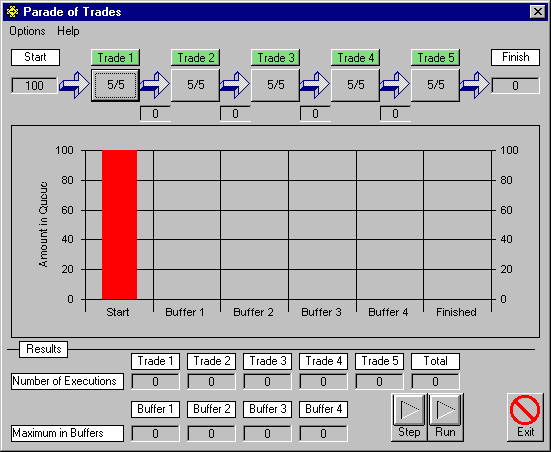|
***********รายละเอียดของโปรแกรม*********
The Parade Game illustrates the impact work flow variability has on the performance of construction trades and their successors. The game consists of simulating a construction process in which resources produced by one trade are prerequisite to work performed by the next trade. Production-level detail, describing resources being passed from one trade to the next, illustrates that throughput will be reduced, project completion delayed, and waste increased by variations in flow. The game shows that it is possible to reduce waste and shorten project duration by reducing the variability in work flow between trades. Basic production management concepts are thus applied to construction management. They highlight two shortcomings of using CPM for field-level planning: CPM makes modeling the dependence of ongoing activities between trades or with operations unwieldy and it does not explicitly represent variability. The Parade Game can be played in a classroom setting either by hand or using a computer. Computer simulation enables students to experiment with numerous alternatives in order to sharpen their intuition regarding variability, process throughput, buffers, productivity, and crew sizing. Managers interested in schedule compression will benefit from understanding work flow variability’s impact on succeeding trade performance.
More detail on the game is given in the following papers:
- Tommelein, I.D., Riley, D., and Howell, G.A. (1998). "Parade Game: Impact of Work Flow Variability on Succeeding Trade Performance." Proc. Sixth Annual Conference of the International Group for Lean Construction, IGLC-6, 13-15 August held in Guaruja, Brazil, 14 pp.
- Tommelein, I.D., Riley, D., and Howell, G.A. (1999). "Parade Game: Impact of Work Flow Variability on Trade Performance." ASCE, J. of Constr. Engrg. and Mgmt., Sept/Oct Issue.
The Parade Game simulation was originally developed by Iris Tommelein, as part of her research on lean construction and new technologies for materials management. This work is funded by grant CMS-9622308 from the National Science Foundation, whose support is gratefully acknowledged. Any opinions, findings, conclusions, or recommendations expressed on this site are those of the authors and do not necessarily reflect the views of the National Science Foundation.
Parade of Trades:
A Computer Game for Understanding Variability and Dependence
by Hyun Jeong Choo and Iris D. Tommelein
Computer Game Instructions
The documentation presented below of the computer implementation of the Parade Game, developed by Huyn Jeong Choo, is written up as (click on the title below to download the .pdf file):
 Choo, H.J. and Tommelein, I.D. (1999). "Parade of Trades: A Computer Game for Understanding Variability and Dependence." Technical Report 99-1, Construction Engineering and Management Program, Civil and Environmental Engineering Department, University of California, Berkeley, September. Choo, H.J. and Tommelein, I.D. (1999). "Parade of Trades: A Computer Game for Understanding Variability and Dependence." Technical Report 99-1, Construction Engineering and Management Program, Civil and Environmental Engineering Department, University of California, Berkeley, September.
Please cite this document when referencing the computer game described on this web page.
- Introduction
The Parade of Trades computer program simulates a dice game. The purpose of this game is to demonstrate the impact variability and dependence have in a construction environment where multiple trades follow each other in a linear sequence and work output by one trade is handed off to the next trade. The term "parade of trades" was coined by Gus Sestrup, a superintendent with Turner Construction.
Greg Howell used the Parade of Trades Game at the 6th Annual Conference of the International Group for Lean Construction and the Lean Construction Institute has been using it at many of their workshops to demonstrate the effects of variability and dependence on work flow. The game was studied and documented in detail by Tommelein et al. (1998, 1999). They used Stroboscope (Martinez 1996) to simulate the Parade Game and collect statistics from the simulation. Alarcon and Ashley (1999) used @Risk (1997) to simulate a slightly modified dice game and analyzed its impact on project cost and schedule.
The present program allows a user to simulate the Parade Game on a computer. By automatically keeping track of the number of rolls (executions per trade), the number of outputs passed to the next trade, and the number of outputs in each buffer between trades, the program helps the user understand what impact variability and dependence may have on work flow.
Click here to see Game Manuals and Instructions
* หากมีปัญหาในการติดตั้ง สอบถามได้ที่เว็บบอร์ดของ www.tumcivil.com
|





